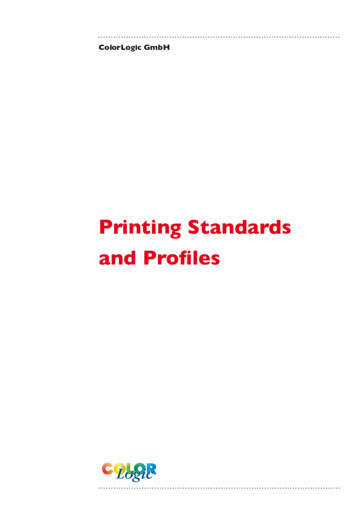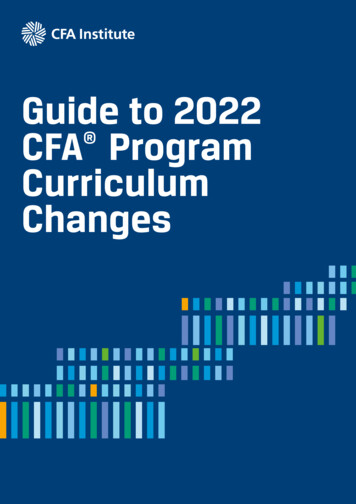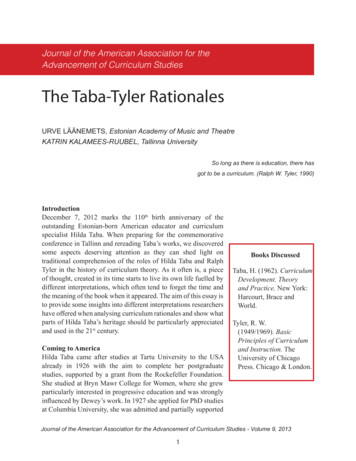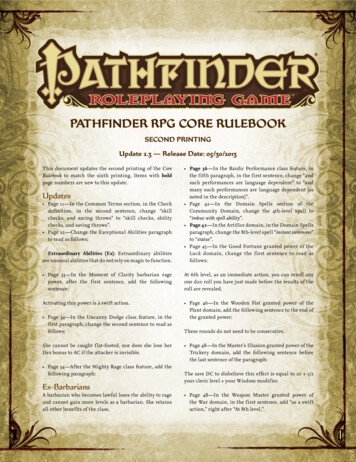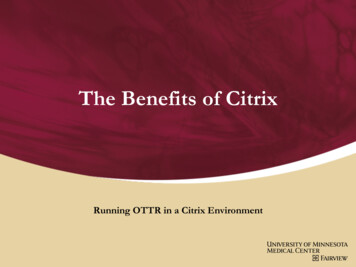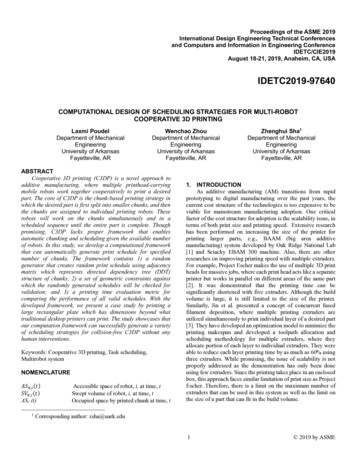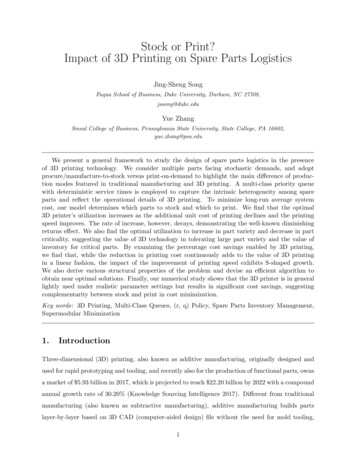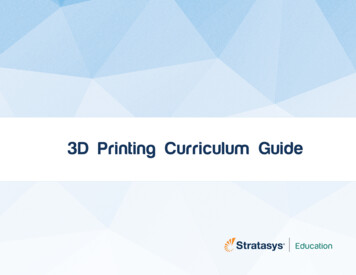
Transcription
3D Printing Curriculum Guide
Table of ContentsTable of Contents . 2Unit 12: Prototype Printing . 33Overview . 3Unit 13: Prototype Printing & Testing . 34About Stratasys Education. 3Unit 14: Final Presentations . 35Career Readiness . 4Unit A: Sound Printing. 36Something That Moves Something . 5Unit B: Fluid Dynamics. 38Introduction to 3D Printing . 6Unit C: Post-Processing . 39Learning Objectives . 6Unit D: Factory of Tomorrow . 41Recommended Course Structure . 7Unit E: Field Trip . 43Requirements . 8Unit F: Regulation & Carbon Footprint . 44Unit 1: Introduction . 9Learning Aids . 45Unit 2: Introduction to 3D Printing . 11Major Projects . 46Unit 3: What is a Mesh? . 13Case Study . 46Unit 4: Ctrl P . 16Final Project . 47Unit 5: Gear Systems Part I . 18Assessment Tools . 49Unit 6: Gear Systems Part II . 21Suggested Course Grading Scheme . 49Unit 7: Dynamic Surfaces and Chains . 23Suggested Project Assessments . 50Unit 8: The Future of Fabrication . 26Exam Question Bank . 53Unit 9: Midterm Exam . 28Credits . 67Unit 10: 4D Printing . 29Legal . 68Unit 11: Parametric Design . 31edu.curriculum@stratasys.com1Something That Moves Something - Introduction to 3D Printing
OverviewAbout Stratasys EducationThe CommunityOur MissionYou’ve joined a worldwide community of educators working to cultivate and expand the use of 3Dprinting in education. Because technology evolves, this curriculum was built to adapt and refreshthrough community input.Stratasys Education is committed to promoting 3D printing ineducation and bridging the gap between academia andindustry. In collaboration with educators like you, we’re leadingcurriculum development for universities and vocational schoolsas well as for research and informal study. Ask us how substantial contributions to this community can make you eligible for free FDM orTMPolyJet 3D Printer cartridges. If you have ideas and supporting content to improve or expand thiscurriculum, email sys.com2Something That Moves Something - Introduction to 3D Printing
Career Readiness“The number of job ads requiring workers with 3D printingskills increased 1,834% in 4 years and 103% whencomparing August 2014 to August 2013.”Source: Wanted AnalyticsReshaping IndustriesThe Third Industrial Revolution is all about personal fabrication and it’s happening now. Powered by Information Age advancements, it is poised to unlock the potential in everyperson to create, innovate and fabricate.While computer-aided additive manufacturing processes have been around for more than 30 years, the technology, now widely known as 3D printing, is reaching a tipping point. It isadvancing rapidly, making its way to consumers, and reshaping manufacturing in the 21st century.3D printing opens up inspiring possibilities and opportunities, like the ability to produce a fully functional “machine” in one print. It is the only manufacturing process that can interlockparts within parts to produce functioning closed systems that require no assembly.Furthermore, because 3D printers produce objects directly from computer models, users can immediately hold, evaluate, test and use their ideas – and share them digitally with theworld. The Internet revolutionized the creation, modification and dissemination of digital media. Now, 3D printing makes that possible for physical objects.3D printing is reshaping the fields of art, design, architecture, science, technology and engineering by revolutionizing how things are made. Recognizing education as the foundationfor career readiness, a means to drive future innovation, we’re providing this curriculum completely free. Use it modularly to supplement an existing class, or teach an entirely newcourse in 3D printing.edu.curriculum@stratasys.com3Something That Moves Something - Introduction to 3D Printing
Something That Moves SomethingCourse SeriesSomething That Moves Something is a series of 3D printingcourses created by Ohad Meyuhas. In this series of courses,students will learn about the evolution of digital fabrication with afull overview of the manufacturing industry and relatedtechnologies.Introduction to 3D Printing:From Design to FabricationBy the end of this introductory course, students will have designed and 3D printed a closed systemthat shifts forces from one point to another using the technical knowledge gained during thesemester.Each hands-on, project-based learning (PBL) course will letstudents design and fabricate 3D objects using computer-aideddesign (CAD) software and 3D printers. They will experience thedesign process and become familiar with the advantages andlimitations of each 3D printing technology in terms of precision,resolution, and material capabilities.Material Memory andMulti-Material PrintingStudents will analyze real industry cases, and apply 3D printingtechnology appropriately while gaining hands-on experiencewith two leading 3D printing technologies employed inmanufacturing today: FDM and PolyJet.Robotics and 3D Printingedu.curriculum@stratasys.com(Coming soon)This course builds on the introductory course and teaches the use of multiple materials in one print.(Coming soon)In this advanced course students incorporate electronics and robotics into 3D printedmachines, taking advantage of the technology’s unique ability to interlock parts withinparts in a single process.4Something That Moves Something - Introduction to 3D Printing
Introduction to 3D PrintingLearning ObjectivesPart of Something That Moves Something, this semester-long course will enrich students’ knowledge in design and applied engineering as they model, fabricate, test, discuss anditerate upon mechanical 3D objects they design throughout the course.Upon completion of this course, students will be able to: Demonstrate knowledge of key historical factors that have shaped manufacturing over the centuriesExplain current and emerging 3D printing applications in a variety of industriesDescribe the advantages and limitations of each 3D printing technologyEvaluate real-life scenarios and recommend the appropriate use of 3D printing technologyIdentify opportunities to apply 3D printing technology for time and cost savingsDiscuss the economic implications of 3D printing including its impact on startup businesses and supply chainsDesign and print objects containing moving parts without assemblyedu.curriculum@stratasys.com5Something That Moves Something - Introduction to 3D Printing
Recommended Course StructureSemester-Long CourseThis course is structured as a 14-week course withweekly class meetings. We recommend that eachmeeting take four to six hours. Alternatively, theweekly meetings can be split into two weekly lecturehours and two to six weekly lab hours.The course is built in a modular fashion so you canfocus on topics that cater to your students’ interestsand fit within your annual curriculum plan. Werecommend adhering to the first four weeks of thecourse structure and adding units and assignments asfitting.edu.curriculum@stratasys.comTIMEFRAME14 weeks (full semester )WEEKLYHOURS4-6 weekly hours, consisting of:2 lecture hours4 lab hoursWEEKLYMEETINGSEach weekly meeting can be taught in one continuous 4-6 hour session, or canbe split into two separate weekly meetings: one for the lecture (theory) and onefor the lab work (hands on).MODULARUNITSThe course consists of 14 units, one per week. However, to support variedstudent interests, six additional units are also available. Mix and match theadditional units as desired. We recommend educators adhere to the first fourweeks of the course structure.6Something That Moves Something - Introduction to 3D Printing
RequirementsClassroom Educator PC with access to:PowerPoint presentation graphicsprogramQuickTime application programInternet connectionStudent PCsInternet connectionProjectorComputer LabThe classroom and computer lab don’t necessarilyneed to be separate spaces. But, in addition to theclassroom requirements listed above, lab sessionsrequire the educator and students to have access tothe CAD software selected for this course.Fabrication Lab We recommend one 3D printer for every 10-15 students. Stratasys 3D Printers are recommended because someprojects require Stratasys-specific printing materials or precision (like FDM thermoplastics with water-soluble supportmaterial or PolyJet photopolymers with rubber-like properties).Also, because Stratasys 3D Printers are those most frequently used in Fortune 500 companies, students will gainmore relevant experience and highly sought-after skills.EducatorTo provide instruction for this course, the educator should have deep knowledge of CAD principles and techniques,and some experience designing for 3D printing. Because every institution and educator has unique software access,preferences and techniques, CAD instruction for this course will rely primarily on educator-provided resources andexpertise.Educators should also have experience operating the 3D printer being used for this class, and coordinate with thefabrication lab manager to arrange access and instruction.StudentsStudents should have prior experience using CAD software, however content and activities can be modified to meet avariety of student interests and skill levels. To complete assignments, students will need access to educator-selectedCAD software outside the classroom, either on their own PC or in a computer lab.edu.curriculum@stratasys.com7Something That Moves Something - Introduction to 3D Printing
Unit 1: IntroductionLearning ObjectivesEssential QuestionsUpon completion of this unit, students will be able to:Use these questions to guide student understanding:1.Explain how technology shifts throughout history have made 3D printing possible.1.Was 3D printing historically inevitable? Why or why not?2.Understand how the designer’s role has evolved over time and how it is likely to2.Has technology helped or hindered creativity? How?change as we move toward mass customization.3.Is there any such thing as a product that cannot be improved?3.Use the principles of Design Thinking and document their design process.4.Navigate the CAD software being used for this course.ClassroomTopicFormatCOURSE OVERVIEWLectureLearning AidsPreparationPrint materialsStudents are introduced to course objectives and syllabus.HISTORICAL REVIEWLectureHistorical Review (PPTX) Print presentation notesStudents will understand how technology shifts throughout history have made 3D printing possible.FROM CAD TO CAMLectureFrom CAD to CAM (PPTX) Print presentation notesBy reviewing the evolution of design and production, students gain broad understanding of the advances that led to today’s manufacturingenvironment. They will understand how humans, machines and code work together to make things.edu.curriculum@stratasys.com8Something That Moves Something - Introduction to 3D Printing
Computer LabTopicFormatLearning AidsPreparationCAD OVERVIEWTutorialEducator-provided content*Lesson planStudents will become familiar with the interface and basic tools available in the CAD software used for this course.FINAL PROJECTEXAMPLELectureInspiring Case Study (PPTX) Something That Moves Something (STL) 3D print STL file providedPrint speaker notesThe Inspiring Case Study presentation will introduce students to Design Thinking and provide an example of what they need to present for their final project.You may choose to dig deeper into Design Thinking by facilitating one of these workshops during classroom or lab time. http://dschool.stanford.edu/dgift/FINAL PROJECTProposal 1*Hands-onFinal Project descriptionPrint project descriptionStudents will apply what they learn in this class to design and 3D print something that moves something. Distribute the final project description that lists theproject requirements. Leave some time for Q & A.If you have an amazing lesson plan you’d like to share with the Stratasys Education Community, tell us.If we add it to our curriculum, you’ll be eligible to receive free FDM or PolyJet materials for your 3D printers.edu.curriculum@stratasys.com9Something That Moves Something - Introduction to 3D Printing
Unit 2: Introduction to 3D PrintingLearning ObjectivesEssential QuestionsUpon completion of this unit, students will be able to:Use these questions to guide student understanding:1.Apply the unique advantages of 3D printing to their designs.1.How might 3D printing change the way products are designed?2.Compare additive manufacturing to traditional technologies and choose the2.Will 3D printing replace traditional fabrication processes?best technology for a given application.3.Is there any such thing as a “perfect” 3D printing technology?3.Distinguish between various 3D printing technologies and materials and selectappropriately for a given application.ClassroomTopicFormatHOMEWORK REVIEWDiscussionLearning AidsPreparationStudents will present their final project proposal and sketch to a peer. They should ask: Am I applying Design Thinking? Are my inspiration andidea clear? Do you understand the direction of my project? What can be improved?3D PRINTING OVERVIEWLectureIntro to 3D Printing (PPTX) 3D print various samples of closed-system 3D models. Use the STL filesprovided by Stratasys or download additional files from GrabCad orThingiverse.Print speaker notesThe special advantages of 3D printing are illuminated by comparison to other technologies, both ancient and modern.3D PRINTING TECHNOLOGYLecture3D Printing Technologies (PPTX) Print speaker notesStudents learn how various 3D printing technologies compare in terms of applications, advantages, relative precision and material use.edu.curriculum@stratasys.com10Something That Moves Something - Introduction to 3D Printing
Computer LabTopicFormatLearning AidsPreparationINTRO TO 3D MODELINGTutorialEducator-provided content*Lesson planStudents will become familiar with the interface and basic tools present in the CAD software used for this course.MEET THE 3D PRINTERTourEducator-provided content*Access to the fabrication labFamiliarize students with available 3D printer(s) including print heads, build envelope, materials used and related support removal system(s).FINAL PROJECTProposal 1Hands-onFinal Project descriptionPrint extra project descriptionsStudents will begin refining their final project proposal and will model their designs in CAD. Use lab time to aid and advise students asneeded, encouraging model complexity.*If you have an amazing lesson plan you’d like to share with the Stratasys Education Community, tell us.If we add it to our curriculum, you’ll be eligible to receive free FDM or PolyJet materials for your 3D printers.edu.curriculum@stratasys.com11Something That Moves Something - Introduction to 3D Printing
Unit 3: What is a Mesh?Learning ObjectivesEssential QuestionsUpon completion of this unit, students will be able to:Use these questions to guide student understanding:1.Define essential geometry terms and understand how they relate to a 3D mesh.1.Can a 3D printed object ever be completely smooth?2.Create smooth and detailed 3D structures.2.Why is file size important? Will it always be?3.Repair a 3D mesh and prepare files for print.3.Why do we call a closed mesh “watertight”?4.Take advantage of model-sharing websites to accelerate learning and improve4.What can we learn by studying designs others have created?product designs.ClassroomTopicFormatHOMEWORK REVIEWDiscussionLearning AidsPreparationStudents will present their revised proposal and CAD model to a peer. They should ask: Am I applying Design Thinking? Are my inspiration and ideaclear? Do you understand the direction of my project? What can be improved?WHAT IS A MESH?LectureWhat is a Mesh? (PPTX) A review of geometry terms conveys the concept of a 3D mesh.edu.curriculum@stratasys.com12Something That Moves Something - Introduction to 3D Printing
Computer LabTopicFormatLearning AidsPreparationMOVING FROM2D TO 3DCAD instructionEducator-provided content*Lesson planTeach common commands for moving from 2D to 3D in CAD. Concentrate on the commands and features that will make your students the mostproficient at completing this week’s assignment: creating or modifying 3D models of everyday objects.ADVANCED CADCOMMANDSCAD instructionEducator-provided content*Lesson planTeach advanced CAD commands that will enhance students’ ability to navigate models in 3D space.MAKING BY SHARINGClass activityMaking by Sharing (PPTX) Print speaker notesStudents will divide into three groups and receive a list of model-sharing websites to review. They will present their findings to the class, following theformat described in the Making by Sharing project description.WEEKLY ASSIGNMENTMaking By Sharing*Hands-onMaking by Sharing assignmentPrint project descriptionStudents will use what they’ve learned so far to design four everyday objects. More details are provided in the project description for Making bySharing. Use lab time to aid and advise students as needed, and encourage model complexity.If you have an amazing lesson plan you’d like to share with the Stratasys Education Community, tell us.If we add it to our curriculum, you’ll be eligible to receive free FDM or PolyJet materials for your 3D printers.edu.curriculum@stratasys.com13Something That Moves Something - Introduction to 3D Printing
Assignment: Making By SharingThis assignment reinforces and extends the classroom learning for Unit 3. This assignment lets students use what they’ve learned from sharing sites like Thingiverse, Shapewaysand GitFab to design four everyday objects that utilize the advantages of 3D printing.DeliverableOPTION 1:Description1.2.3.Choose four models from a sharing site like Thingiverse, Shapeways or Gitfab.Improve upon a file and make it your own. Some ideas include: Redesign it with a specific user in mind Redesign it for a slightly different purpose Improve the look of the productDocument and explain the changes you made to the file and why you made those changes.1.2.Design a product from scratch and upload it to a model sharing website.Write detailed instructions for printing and include them when you upload your file.Improvements to four everyday objects (STL)OPTION 2:Four everyday objects from scratch (STL)edu.curriculum@stratasys.com14Something That Moves Something - Introduction to 3D Printing
Unit 4: Ctrl PLearning ObjectivesUpon completion of this unit, students will be able to:1.Use the CAM software to prepare files for 3D printing.2.Manipulate machine movement and material layering.ClassroomTopicHOMEWORK REVIEWMaking By Sharingedu.curriculum@stratasys.comFormatLearning AidsPreparationDiscussionStudents will present their four consumer products or everyday objects to a peer and exchange feedback.15Something That Moves Something - Introduction to 3D Printing
Computer LabTopicFormatLearning AidsPreparationCAM SKILLSTutorialCatalyst (PPTX), Insight (PPTX) orObjet Studio (PPTX) Print speaker notesStudents will learn how to use the CAM software that powers the school’s 3D printer. If none of the provided presentations apply, prepare your owntutorial. Concentrate on commands and features that will make your students most proficient at preparing files for print.MESH REPAIRHands-onWhat is a Mesh? (PPTX) Demonstrate how to repair a 3D mesh usinga)b)c)Freeware utilities:Autodesk MeshMixer (http://goo.gl/x5nhYc), MeshLab (http://goo.gl/fgztLl) or Netfabb Basic or Cloud Service (http://goo.gl/Q1P47a)Freeware tool tutorials:Netfabb Basic or Cloud Service (http://goo.gl/Q1P47a), Netfabb and MeshLab (http://goo.gl/WPOVec)Professional tools:Magics or NetfabbGET TO KNOW THE3D PRINTERTourWEEKLY ASSIGNMENTMaking By SharingHands-on*Educator-provided content*Access to fabrication labVisit the fabrication lab and explain additional details about how your school’s 3D printer works. Ask lab manager to explain processes formaintenance, support removal, and reserving access to 3D printers.Making by Sharing assignmentStudents will refine their models of everyday objects based on feedback from their peers. More details are provided in the project description forMaking by Sharing. Use lab time to aid and advise students as needed, encouraging model complexity.If you have an amazing lesson plan you’d like to share with the Stratasys Education Community, tell us.If we add it to our curriculum, you’ll be eligible to receive free FDM or PolyJet materials for your 3D printers.edu.curriculum@stratasys.com16Something That Moves Something - Introduction to 3D Printing
Unit 5: Gear Systems Part ILearning ObjectivesEssential QuestionsUpon completion of Units 5 & 6, students will be able to:Use these questions to guide student understanding:1.Build a gear system in CAD.1.Is the ability to create a full gear system in one print extraordinary?2.Convert 2D gear drawings to 3D models.2.How do you interact with a 3D design differently than a 2D design?3.Design systems with 3D printing technology in mind, including minimum tolerance3.Are gear systems obsolete? Will they ever be?and material thickness.ClassroomTopicFormatHOMEWORK REVIEWMaking By SharingDiscussionGEAR SYSTEMSLearning AidsPreparationStudents will present their refined consumer products or everyday objects to a peer and exchange feedback.LectureGear Systems (PPTX) Students are introduced to the operating principles of gear systems, and learn the advantages and limitations of 3D printing them.CASE STUDYLectureDa Vinci Case Study (PPTX) Gear System Case Study (PPTX) Gear Ball Case Study (PPTX) Print speaker notes3D print STL files providedGear System 16 (STL) U05 FDM Da Vinci (STL) U05 FDM Gear System 26 (STL) Review one of these case studies with students to highlight the challenges and advantages of 3D printing gear systems.edu.curriculum@stratasys.com17Something That Moves Something - Introduction to 3D Printing
Computer LabTopicFormatLearning AidsPreparationDESIGNINGGEARS IN CADCAD instructionEducator-provided content*Lesson planWEEKLY ASSIGNMENTGear SystemsHands-on*Introduce formulas for determining gear specifications given tooth count and diameter. Teach students how to redesign 2D gear drawings as 3Dmodels using photographs or old blueprints.Gear Systems assignmentPrint handoutsStudents will begin designing a gear system of their own. Details for two project options are provided in the project description for Gear Systems. Uselab time to aid and advise students as needed, encouraging model complexity.If you have an amazing lesson plan you’d like to share with the Stratasys Education Community, tell us.If we add it to our curriculum, you’ll be eligible to receive free FDM or PolyJet materials for your 3D printers.edu.curriculum@stratasys.com18Something That Moves Something - Introduction to 3D Printing
Assignment: Gear SystemsThese assignments reinforce and extend the classroom learning for Units 5 & 6.DeliverablesOPTION 1:Gear System (STL)Requirements1.2.3.Design a system that uses more than one gear to produce motion.Consider the trade-offs between speed and force and document your design decisions.Consider the tolerance and layer thickness capabilities of the 3D printer you’ll use, and document design decisions related to those capabilities.OPTION 2:Da Vinci Machine (STL)In this assignment, you’ll get inside the shoes of a great artist, inventor and engineer.DOCUMENTATION &PRESENTATIONBoth options require documentation and a final presentation. Your presentation should include a video of your final product in action and shoulddemonstrate your use of Design Thinking. As you work, be sure to address your problems, challenges and lessons learned. Include the following:1.2.3.Find a da Vinci machine sketch and reproduce it using CAD.Consider the ways in which 3D printing differs from Renaissance-era fabrication technologies and adjust the designs accordingly.Consider the tolerance and layer thickness capabilities of the 3D printer you’ll use, and document design decisions related to those capabilities.Material use: What design challenges have you encountered as a result of your material? If you could have chosen another material, what would youhave chosen?Technology: What design challenges have you encountered as a result of your 3D printing technology? If you had access to other fabricationtechnology, what would you have chosen? Why?Wall thickness: Have you encountered problems with thin areas in your model? Were any supporting parts affected? How did you fix this?Details: Does your design contain areas with small embossed or engraved features? Are they necessary for your design to function? Have youencountered issues with details getting lost?Holes and Gaps: Have you encountered any tiny holes or gaps? How did you fix this?Scaling: Have you been able to resolve some of your issues by increasing the scale of your model? Or have you had to significantly alter your design?edu.curriculum@stratasys.com19Something That Moves Something - Introduction to 3D Printing
Unit 6: Gear Systems Part IIClassroomTopicFormatHOMEWORK REVIEWGear SystemsDiscussionKINEMATIC MODELSLearning AidsPreparationStudents will present their gear model from last week to a peer and exchange feedback.Lecture, discussion or activityEducator-provided content*Lesson planRecommended resources:- Cornell University Brings Pieces of History Back to Life - http://goo.gl/826TLB- Kinematic Models Digital Library (Cornell University) - http://goo.gl/JvwuVUCASE STUDYDa Vinci case study (PPTX) Gear System case study (PPTX) Gear Ball case study (PPTX) Print speaker notesReview one of these case studies with students to highlight more challenges and advantages of 3D printing gear systems.*If you have an amazing lesson plan you’d like to share with the Stratasys Education Community, tell us.If we add it to our curriculum, you’ll be eligible to receive free FDM or PolyJet materials for your 3D printers.edu.curriculum@stratasys.com20Something That Moves Something - Introduction to 3D Printing
Computer LabTopicFormatWEEKLY ASSIGNMENTGear g AidsPreparationStudents will improve upon the gear system they began designing last week and incorporate feedback from their peers. Use lab time to aid andadvise students as needed, encouraging model complexity. Students will need to complete their models as homework if they don’t finish in class.21Something That Moves
3D Printer cartridges. If you have ideas and supporting content to improve or expand this curriculum, email . edu.curriculum@stratasys.com. Our Mission . Stratasys Education is committed to promoting 3D printing in education and bridging the gap between academia and industry

